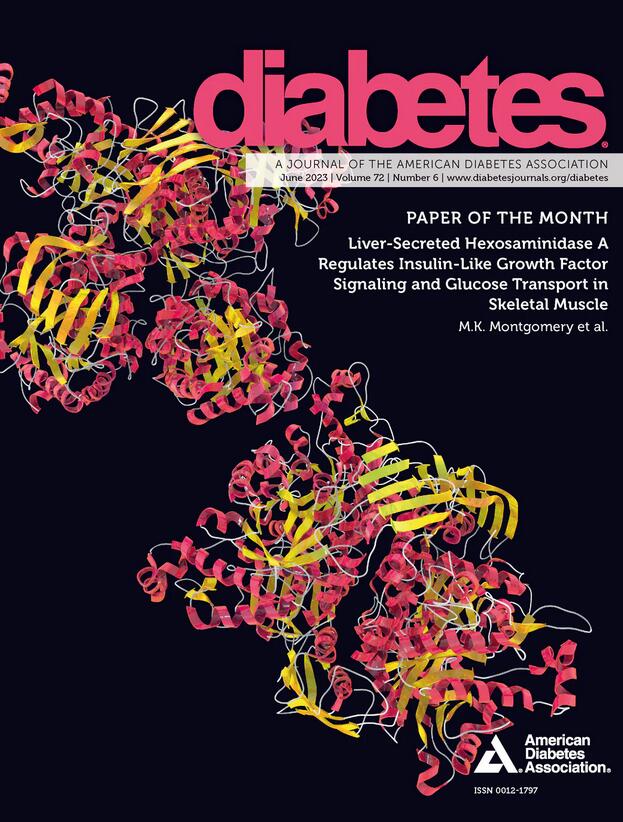Deleterious Effects of a GAD65 Monoclonal Autoantibody on Islet Function
IF 7.5
1区 医学
Q1 ENDOCRINOLOGY & METABOLISM
引用次数: 0
Abstract
An intrinsic hallmark of type 1 diabetes is the correlation between appearance of autoantibodies directed against islet cell autoantigens with subsequent development of the disease. We recently studied effects of human monoclonal autoantibodies (mAbs) derived from a patient with prediabetes and demonstrated that a GAD65mAb penetrated and accumulated in β-cells and significantly reduced the insulin secretion rate (ISR). Accordingly, in the current study, we performed more detailed analyses of the effects of this GAD65mAb on rat and human islets. ISR was suppressed by ∼40% after 3 days of exposure. Mechanisms mediating the effects were found to involve inhibition of mitochondrial generation of ATP, which decreased in parallel with that of ISR. As expected, the GAD65mAb inhibited γ-aminobutyric acid secretion. The effects of GAD65mAb were observed in rat and human islets but not in mouse islets, which do not express GAD65. GAD65mAb also reduced insulin secretion in vivo, where decreased insulin levels after intraperitoneal (i.p.) injection of glucose were observed in rats after i.p. injection of GAD65mAb. Thus, it appears that an islet cell autoantibody against GAD65 can directly impact and impair secretory function in islets in vitro and in vivo through a mechanism that involves inhibition of mitochondrial energetics. ARTICLE HIGHLIGHTS This study was undertaken to further investigate the ability of a monoclonal autoantibody to GAD65 from a patient with pre–type 1 diabetes to be deleterious to islet function. The study was designed to further characterize the effects, understand the mechanism mediating the effects, and demonstrate that the effects were operational in vivo. The effects of the GAD65 monoclonal antibody reduced ATP, γ-aminobutyric acid secretion, and insulin secretion with a similar time course and concentration dependency, which appeared to be mediated by effects on mitochondrial energetics and were similar in vivo in rats as in vitro. These findings raise the possibility that autoantibodies could play a pathogenic role in the development of type 1 diabetes.GAD65单克隆自身抗体对胰岛功能的有害影响
1型糖尿病的一个内在特征是针对胰岛细胞自身抗原的自身抗体的出现与疾病的后续发展之间的相关性。我们最近研究了来自糖尿病前期患者的人单克隆自身抗体(mab)的作用,并证明GAD65mAb穿透并积聚在β细胞中,并显着降低胰岛素分泌率(ISR)。因此,在当前的研究中,我们对GAD65mAb对大鼠和人胰岛的影响进行了更详细的分析。暴露3天后,ISR被抑制约40%。研究发现,介导这种效应的机制涉及抑制线粒体生成ATP, ATP与ISR同时减少。正如预期的那样,GAD65mAb抑制γ-氨基丁酸分泌。GAD65mAb在大鼠和人胰岛中观察到作用,但在不表达GAD65的小鼠胰岛中没有观察到作用。GAD65mAb还能降低体内胰岛素分泌,腹腔注射葡萄糖后大鼠胰岛素水平下降。因此,针对GAD65的胰岛细胞自身抗体似乎可以通过抑制线粒体能量学的机制直接影响和损害体外和体内胰岛的分泌功能。本研究旨在进一步研究来自1型糖尿病患者的GAD65单克隆自身抗体对胰岛功能的危害。本研究旨在进一步表征其效应,了解其介导机制,并证明其在体内具有可操作性。GAD65单克隆抗体对ATP、γ-氨基丁酸分泌和胰岛素分泌的影响具有相似的时间过程和浓度依赖性,这可能是通过对线粒体能量学的影响介导的,并且在体内与体外相似。这些发现提出了自身抗体可能在1型糖尿病的发展中起致病作用的可能性。
本文章由计算机程序翻译,如有差异,请以英文原文为准。
求助全文
约1分钟内获得全文
求助全文
来源期刊

Diabetes
医学-内分泌学与代谢
CiteScore
12.50
自引率
2.60%
发文量
1968
审稿时长
1 months
期刊介绍:
Diabetes is a scientific journal that publishes original research exploring the physiological and pathophysiological aspects of diabetes mellitus. We encourage submissions of manuscripts pertaining to laboratory, animal, or human research, covering a wide range of topics. Our primary focus is on investigative reports investigating various aspects such as the development and progression of diabetes, along with its associated complications. We also welcome studies delving into normal and pathological pancreatic islet function and intermediary metabolism, as well as exploring the mechanisms of drug and hormone action from a pharmacological perspective. Additionally, we encourage submissions that delve into the biochemical and molecular aspects of both normal and abnormal biological processes.
However, it is important to note that we do not publish studies relating to diabetes education or the application of accepted therapeutic and diagnostic approaches to patients with diabetes mellitus. Our aim is to provide a platform for research that contributes to advancing our understanding of the underlying mechanisms and processes of diabetes.
 求助内容:
求助内容: 应助结果提醒方式:
应助结果提醒方式:


